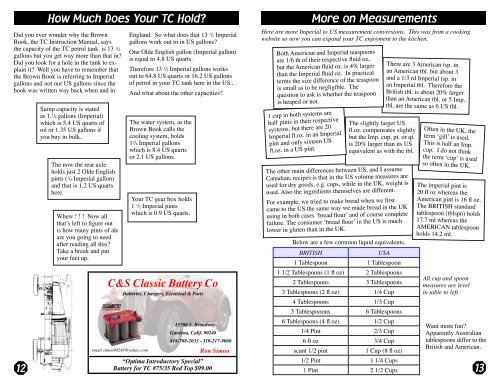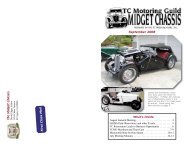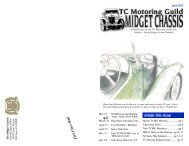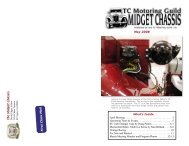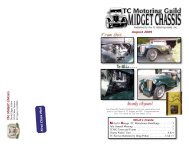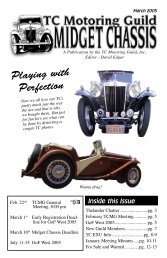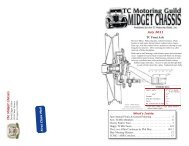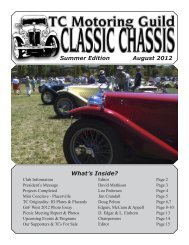November Midget Chassis - TC Motoring Guild
November Midget Chassis - TC Motoring Guild
November Midget Chassis - TC Motoring Guild
You also want an ePaper? Increase the reach of your titles
YUMPU automatically turns print PDFs into web optimized ePapers that Google loves.
Did you ever wonder why the Brown<br />
Book, the <strong>TC</strong> Instruction Manual, says<br />
the capacity of the <strong>TC</strong> petrol tank is 13 1 /2<br />
gallons but you get way more than that in?<br />
Did you look for a hole in the tank to explain<br />
it? Well you have to remember that<br />
the Brown Book is referring to Imperial<br />
gallons and not our US gallons since the<br />
book was written way back when and in<br />
12<br />
How Much Does Your <strong>TC</strong> Hold?<br />
Sump capacity is stated<br />
as 1. 1 /8 gallons (Imperial)<br />
which is 5.4 US quarts of<br />
oil or 1.35 US gallons if<br />
you buy in bulk.<br />
The now the rear axle<br />
holds just 2 Olde English<br />
pints ( 1 /4 Imperial gallon)<br />
and that is 1.2 US quarts<br />
here.<br />
Whew ! ! ! Now all<br />
thatʼs left to figure out<br />
is how many pints of ale<br />
are you going to need<br />
after reading all this?<br />
Take a break and put<br />
your feet up.<br />
C&S Classic Battery Co<br />
Batteries, Chargers, Electrical & Parts<br />
email simon90248@yahoo.com<br />
England. So what does that 13 1 /2 Imperial<br />
gallons work out to in US gallons?<br />
One Olde English gallon (Imperial gallon)<br />
is equal to 4.8 US quarts.<br />
Therefore 13 1 /2 Imperial gallons works<br />
out to 64.8 US quarts or 16.2 US gallons<br />
of petrol in your <strong>TC</strong> tank here in the US..<br />
And what about the other capacities?<br />
The water system, as the<br />
Brown Book calls the<br />
cooling system, holds<br />
1 3 /4 Imperial gallons<br />
which is 8.4 US quarts<br />
or 2.1 US gallons.<br />
Your <strong>TC</strong> gear box holds<br />
1 1 /2 Imperial pints<br />
which is 0.9 US quarts.<br />
15700 S. Broadway<br />
Gardena, Calif. 90248<br />
818-708-2033 - 310-217-9060<br />
“Optima Introductory Special”<br />
Battery for <strong>TC</strong> #75/35 Red Top $99.00<br />
Ron Simon<br />
More on Measurements<br />
Here are more Imperial to US measurement conversions. This was from a cooking<br />
website so now you can expand your <strong>TC</strong> enjoyment to the kitchen.<br />
Both American and Imperial teaspoons<br />
are 1/6 th of their respective fluid oz,<br />
but the American fluid oz. is 4% larger<br />
than the Imperial fluid oz. In practical<br />
terms the size difference of the teaspoon<br />
is small as to be negligible. The<br />
question to ask is whether the teaspoon<br />
is heaped or not.<br />
1 cup in both systems are<br />
half pints in their respective<br />
systems, but there are 20<br />
Imperial fl.oz. in an Imperial<br />
pint and only sixteen US<br />
fl.oz. in a US pint.<br />
The slightly larger US<br />
fl.oz. compensates slightly<br />
but the Imp. cup, pt. or qt.<br />
is 20% larger than its US<br />
equivalent as with the tbl.<br />
The other main differences between US, and I assume<br />
Canadian, recipes is that in the US volume measures are<br />
used for dry goods, e.g. cups, while in the UK, weight is<br />
used. Also the ingredients themselves are different.<br />
For example, we tried to make bread when we first<br />
came to the US the same way we made bread in the UK<br />
using in both cases ʻbread flourʼ and of course complete<br />
failure. The consumer ʻbread flourʼ in the US is much<br />
lower in gluten than in the UK.<br />
Below are a few common liquid equivalents.<br />
BRITISH<br />
USA<br />
1 Tablespoon 1 Tablespoon<br />
1 1/2 Tablespoons (1 fl oz) 2 Tablespoons<br />
2 Tablespoons 3 Tablespoons<br />
3 Tablespoons (2 fl oz) 1/4 Cup<br />
4 Tablespoons 1/3 Cup<br />
5 Tablespooons 6 Tablespoons<br />
6 Tablespoons (4 fl oz) 1/2 Cup<br />
1/4 Pint 2/3 Cup<br />
6 fl oz 3/4 Cup<br />
scant 1/2 pint<br />
1 Cup (8 fl oz)<br />
1/2 Pint 1 1/4 Cups<br />
1 Pint 2 1/2 Cups<br />
There are 3 American tsp. in<br />
an American tbl. but about 3<br />
and a 1/3 rd Imperial tsp. in<br />
an Imperial tbl. Therefore the<br />
British tbl. is about 20% larger<br />
than an American tbl. or 5 Imp.<br />
tbl. are the same as 6 US tbl.<br />
Often in the UK, the<br />
term ʻgillʼ is used.<br />
This is half an Imp.<br />
cup. I do not think<br />
the term ʻcupʼ is used<br />
so often in the UK.<br />
The imperial pint is<br />
20 fl oz whereas the<br />
American pint is 16 fl oz.<br />
The BRITISH standard<br />
tablespoon (tblspn) holds<br />
17.7 ml whereas the<br />
AMERICAN tablespoon<br />
holds 14.2 ml.<br />
All cup and spoon<br />
measures are level<br />
in table to left.<br />
Want more fun?<br />
Apparently Australian<br />
tablespoons differ to the<br />
British and American.<br />
13


